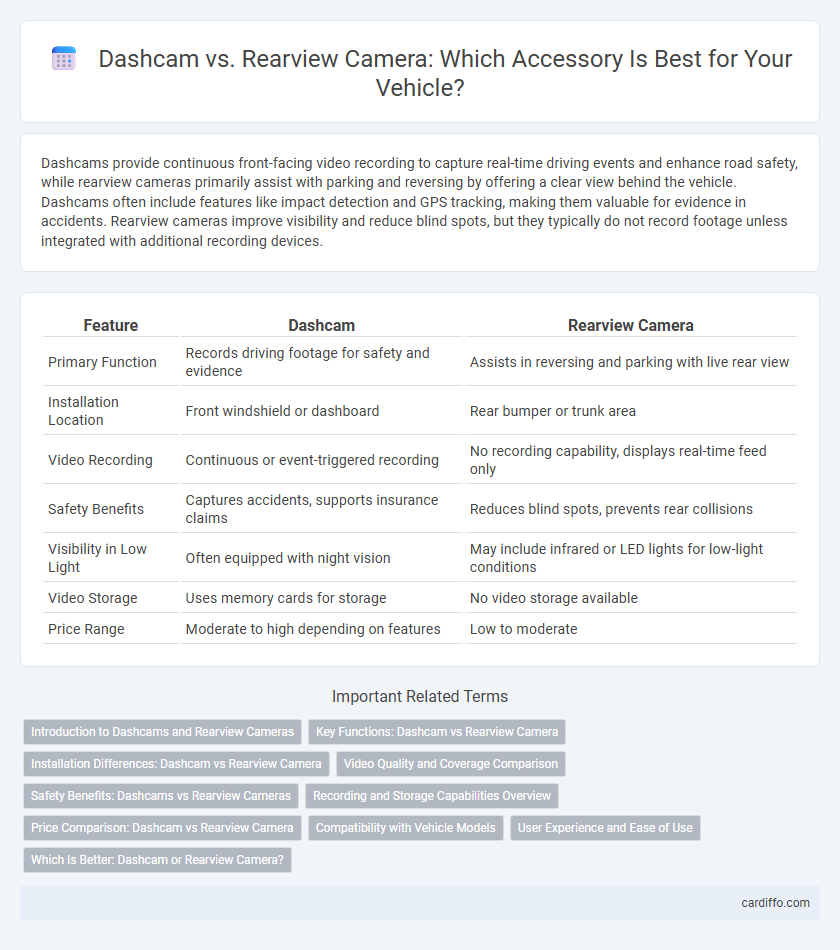Dashcams provide continuous front-facing video recording to capture real-time driving events and enhance road safety, while rearview cameras primarily assist with parking and reversing by offering a clear view behind the vehicle. Dashcams often include features like impact detection and GPS tracking, making them valuable for evidence in accidents. Rearview cameras improve visibility and reduce blind spots, but they typically do not record footage unless integrated with additional recording devices.
Table of Comparison
| Feature | Dashcam | Rearview Camera |
|---|---|---|
| Primary Function | Records driving footage for safety and evidence | Assists in reversing and parking with live rear view |
| Installation Location | Front windshield or dashboard | Rear bumper or trunk area |
| Video Recording | Continuous or event-triggered recording | No recording capability, displays real-time feed only |
| Safety Benefits | Captures accidents, supports insurance claims | Reduces blind spots, prevents rear collisions |
| Visibility in Low Light | Often equipped with night vision | May include infrared or LED lights for low-light conditions |
| Video Storage | Uses memory cards for storage | No video storage available |
| Price Range | Moderate to high depending on features | Low to moderate |
Introduction to Dashcams and Rearview Cameras
Dashcams capture continuous video footage of the road ahead, providing critical evidence in case of accidents or traffic incidents. Rearview cameras enhance vehicle safety by offering a clear view behind the vehicle, aiding in parking and preventing collisions with obstacles or pedestrians. Both devices integrate with modern vehicle systems, contributing to overall driver awareness and accident prevention.
Key Functions: Dashcam vs Rearview Camera
Dashcams primarily offer continuous front-facing video recording to capture driving incidents and provide evidence during accidents, ensuring driver safety and accountability. Rearview cameras enhance vehicle safety by providing real-time video of the area behind the car, assisting with parking and preventing collisions with obstacles or pedestrians. Both accessories improve overall vehicle security, but dashcams focus on incident documentation while rearview cameras prioritize collision avoidance and enhanced visibility.
Installation Differences: Dashcam vs Rearview Camera
Dashcam installation typically involves mounting the device on the windshield near the rearview mirror and connecting it to the vehicle's power source, often via the cigarette lighter or hardwired fuse box. Rearview camera installation requires mounting the camera at the vehicle's rear, usually above the license plate, and routing wires through the car's interior to connect with the display screen on the dashboard or rearview mirror. Dashcams usually offer simpler installation due to fewer wiring requirements, while rearview cameras demand more complex wiring and integration with the vehicle's existing systems.
Video Quality and Coverage Comparison
Dashcams typically offer higher video quality with 1080p or 4K resolution options, capturing both front and sometimes rear views with wide-angle lenses that cover extensive road areas. Rearview cameras prioritize real-time rear coverage with wide fields of view around 120 to 180 degrees but usually feature lower resolution, such as 720p or 960p, optimized for parking assistance rather than detailed video recording. The broader coverage and superior video quality of dashcams make them more effective for comprehensive incident documentation compared to rearview cameras' specialized but limited rear visibility.
Safety Benefits: Dashcams vs Rearview Cameras
Dashcams provide continuous recording of the road ahead, capturing critical evidence in accidents and enhancing overall driver accountability. Rearview cameras improve safety by eliminating blind spots during reversing, reducing the risk of collisions with pedestrians or obstacles. Both devices complement each other in promoting comprehensive situational awareness and preventing accidents.
Recording and Storage Capabilities Overview
Dashcams typically provide continuous recording with loop storage, capturing high-definition video files stored on removable memory cards such as microSD, enabling easy transfer and review. Rearview cameras primarily serve live video display with limited or no recording functionality, often relying on the vehicle's infotainment system and lacking dedicated storage options. Advanced dashcams may feature event-triggered recording and cloud backup, offering enhanced security beyond mere rearview monitoring.
Price Comparison: Dashcam vs Rearview Camera
Dashcams typically range from $50 to $200 depending on features such as resolution and connectivity, while rearview cameras usually cost between $25 and $100, reflecting simpler technology focused on parking assistance. High-end dashcams with advanced functions like GPS and collision detection drive prices upward, whereas rearview camera systems integrated with infotainment displays can increase installation expenses. Overall, dashcams represent a higher initial investment compared to basic rearview cameras, but both vary widely based on specifications and brand.
Compatibility with Vehicle Models
Dashcams offer broad compatibility with most vehicle models, as they typically mount on the windshield and connect to standard power outlets. Rearview cameras require integration with specific vehicle systems or aftermarket monitors, making compatibility dependent on the model's existing display setup. Selecting the right accessory involves verifying connection types and screen compatibility to ensure seamless installation and functionality.
User Experience and Ease of Use
Dashcams offer continuous front and sometimes rear recording, providing comprehensive coverage and peace of mind for drivers, while rearview cameras primarily assist with parking by delivering real-time video of the area behind the vehicle. The user experience with dashcams is enhanced by features such as automatic recording upon ignition and loop recording, minimizing the need for manual intervention. Rearview cameras prioritize ease of use with clear, immediate display activation during reverse gear, streamlining parking maneuvers and accident prevention without complex setup.
Which Is Better: Dashcam or Rearview Camera?
Dashcams provide continuous video recording of the road ahead, capturing crucial evidence in case of accidents or road incidents, while rearview cameras primarily assist with parking and reversing by displaying live footage behind the vehicle. Dashcams offer broader protection with features like GPS tracking and impact sensors, making them ideal for overall driving safety, whereas rearview cameras enhance visibility to prevent backing collisions. Choosing between a dashcam and a rearview camera depends on whether the priority is comprehensive incident documentation or improved rear visibility during maneuvers.
Dashcam vs Rearview camera Infographic

 cardiffo.com
cardiffo.com